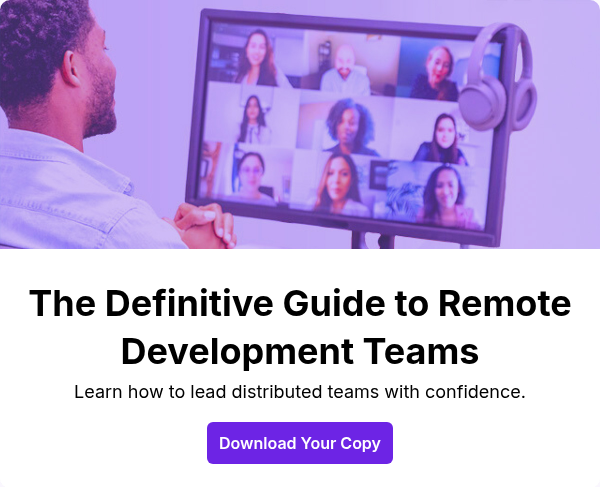Developer Onboarding With Empathy, Clarity and Connection
July 28, 2025 8 min read

When you're moving fast, it's tempting to treat developer onboarding as a checklist of paperwork and logins to rush through.
This is a costly oversight, especially for growing companies where losing talent can significantly slow momentum. According to the CIPD Resourcing and Talent Planning Report 2024, nearly 40% of organizations report new hires leaving within their first 12 weeks—a clear sign that traditional onboarding often falls short.
Great onboarding processes prioritize empathy, clarity, and genuine human connections. By creating psychological safety and engaging developers meaningfully during onboarding, you can reduce turnover as you scale your development team.
“Onboarding is cultural infrastructure. That’s what sets the tone for how things are going to be,” says Tom Stinson, vice president of people and culture at X-Team.
What Is Developer Onboarding?
Developer onboarding is the process of integrating a new engineer into your team with the tools, context, and support they need to contribute effectively. It goes beyond logins and documentation. A strong software developer onboarding process gives developers a clear understanding of the systems they’re working within, the standards they’re expected to follow, and the company culture they’re stepping into.
Typical onboarding activities include:
- Meeting your manager and teammates
- Reviewing payroll, benefits, and administrative processes
- Getting familiar with the development environment and tools
- Understanding communication channels and team workflows
- Setting initial performance and deployment goals
- Receiving an overview of coding standards and documentation
Onboarding developers means preparing them to contribute inside unfamiliar and complex systems. They need access to repos, dev environments, and deployment processes, but just as importantly, they need to understand how decisions get made, where to find answers, and how communication flows across the team.
Onboarding remote developers adds another layer of complexity. There’s no hallway chat or quick desk-side explanation. Communication delays and missing context can turn small uncertainties into major slowdowns. A strong remote onboarding experience fills those gaps early, giving developers the clarity they need to contribute with speed and confidence as part of the team.

7 Developer Onboarding Best Practices of High-Performing Teams
At X-Team, we’ve been refining remote developer onboarding since 2006—both by supporting developers joining our own community and integrating with client teams. Nearly two decades of experience have taught us that successful onboarding isn’t about speed; it’s about laying the right foundation for long-term success. Here’s what that looks like in action.
Assign an Onboarding Buddy
Every developer should have a buddy who can quickly answer questions and offer guidance. This single point of support strengthens human connection and accelerates confidence and learning.
At X-Team, this role takes the form of a “wizard”—a dedicated advocate who ensures the developer feels supported and connected from day one and beyond. Wizards act as a primary point of contact for everything from access issues to cultural guidance. “It’s like having a safe point in the company,” says Amadeu Linhares, X-Team developer. “If I didn’t know something, I could ping my wizard, and they’d find the answer.”
Provide Access and Context
Access and context must go hand in hand. New software engineers need credentials, yes—but they also need to know how the product works, why decisions are made, and what the roadmap looks like. Without both, momentum stalls. “If you can’t get into the systems, you can’t do anything,” says Simone Ryland, Client Enablement Manager at X-Team.
Promote Psychological Safety
Set the tone early: Mistakes are expected and learning is part of the process. Encourage open questions and make it safe to admit uncertainty. Psychological safety accelerates learning and builds trust across the team. "We want people to feel safe asking questions, even making mistakes, because that’s how you learn and build trust," Tom says.
Maintain Documentation in Multiple Formats
Outdated docs create friction, but so does limiting information to one medium. Pair written documentation with Loom walkthroughs and reinforce them via Slack workflows. “We’re very aware that people learn differently,” Tom says. “I’m very visual, so if you just give me a bunch of written docs, I’ll struggle. That’s why we provide information in multiple ways—written, visual, and live.”
Clarify Cultural Expectations
Remote and distributed teams span multiple cultures and norms. Explain upfront how decisions are made, what communication styles are valued, and any team rituals or meeting etiquette. This clarity helps avoid misunderstandings and fosters empathy. “We encourage everybody to bring who they are and their experiences,” Tom notes.
Establish Tight Feedback Rhythms
Check in often—daily in the first week, then weekly for the first month. These feedback loops uncover blockers early and confirm progress, preventing small issues from becoming big problems. “The more you can just be curious and keep communication open, the better," Simone says. "You can’t let questions sit; proactive check-ins prevent misunderstandings and build trust. Frequent check-ins build trust and stop minor issues from spiraling.”
Introduce Real Work Sooner Rather Than Later
Move beyond theory quickly. Assign small, meaningful tasks in the first two weeks to create early wins and build confidence. Use pair programming or shadowing to reduce friction and accelerate contribution. “The first week is always setup, the environment, onboarding and getting ready," Amadeu says. "Starting the second week is a good time to start a task, maybe open a PR."
By following these principles, you can turn onboarding from an administrative task into a strategic advantage.

A Timeline for Effective Developer Onboarding
A strong onboarding plan creates clarity at every stage and prevents common pitfalls like access delays, context gaps, and early attrition. Here’s a proven timeline that balances structure with flexibility.
Pre-Onboarding (Before Day 1)
- Provision all tools, credentials, and equipment in advance.
- Share a team playbook outlining communication norms, coding standards, and workflows.
- Send a “Day One Preview” with who they’ll meet and what to expect.
Week 1: Clarity and Confidence
- Walk through active projects and explain how the role connects to team goals.
- Set a goal for a small but meaningful first contribution.
- Schedule daily check-ins to surface blockers and reinforce progress.
Weeks 2–4: Building Momentum
- Assign progressively complex tasks tied to core priorities.
- Use pair programming or shadowing to speed up context-building.
- Hold weekly feedback sessions and celebrate early wins.
30-90 Days: Autonomy and Ownership
- Shift from task-level work to strategic contributions.
- Conduct structured retrospectives at 30, 60, and 90 days.
- Continuously refine onboarding docs based on developer feedback.
A structured timeline not only accelerates ramp-up but ensures developers feel supported and confident throughout their journey.
Beyond 90 Days: Continuing Support
- Provide regular alignment updates with project stakeholders.
- Refresh and expand access to evolving documentation and resources.
- Keep developers connected through ongoing community and growth programs.
This ongoing investment benefits clients by ensuring developers remain aligned with goals, highly productive, and motivated far beyond the first few months.
5 Challenges Unique to Remote Onboarding
For companies outsourcing software development , onboarding plays an even bigger role in ensuring developers align quickly with team norms and project goals. These issues can significantly affect how quickly and confidently new hires integrate into your team.
Information Overload
Without the natural pacing of in-person onboarding, remote developers often receive an avalanche of documents, logins, and processes all at once. This flood of information can create confusion and stress, making it hard to prioritize what matters most.
Lack of Immediate Support
In an office, a question can be resolved in seconds. In a remote setting, unanswered questions can linger for hours or even days, creating bottlenecks and frustration for new hires.
Cultural Disconnect
Remote work removes the spontaneous interactions that help shape company culture. Without deliberate cultural integration, developers can feel isolated and disconnected from the values and norms of the organization.
Unclear Expectations and Processes
When workflows, coding standards, or role expectations aren’t clearly documented, remote developers are left guessing. This uncertainty increases errors and slows down ramp-up time.
Time Zone Friction
Distributed teams rarely share overlapping working hours, leading to delays in communication and decision-making. These delays can disrupt onboarding momentum and impact early contributions.

How to Onboard Remote Developers Across Time Zones
Global teams rarely share all working hours, so onboarding has to work without relying on real-time conversations. The solution? Build an async-first approach that empowers developers to start strong, regardless of location.
Build for Async Communication
An async-first approach starts with clear, structured resources. Replace real-time walkthroughs with kickoff playbooks and Loom videos that provide detailed explanations of tools, workflows, and company norms. This ensures every new hire gets the same consistent information without waiting for a meeting.
Provide Self-Serve Projects
When onboarding remote developers, give them access to sandbox environments and starter tasks. Self-serve projects let them experiment with tools, test deployments, and learn your systems without being blocked by time zones. This hands-on practice boosts confidence before they touch production code.
Master Asynchronous Communication
Async isn’t just about sending messages—it’s about setting clear expectations. Define response-time guidelines (e.g., within 24 hours) and make every message context-rich to avoid unnecessary back-and-forth. The goal is to keep work moving without requiring everyone to be online at the same time.
Record and Document Everything
Meetings will need to happen, but don’t let them become single points of failure. Record sessions and share concise, searchable notes in your knowledge base. This way, developers never miss critical context—even if they’re asleep when the meeting happens.
Async onboarding removes bottlenecks and fosters deep work for developers while keeping collaboration smooth across geographies. As Simone Ryland says: “If you plan ahead and give all the context upfront, everyone can keep moving even when you’re offline.”

4 Metrics to Measure Onboarding Success
A strong onboarding program is also tied to outcomes. Track these key metrics to gauge impact.
- Time to First Pull Request (PR): How long it takes a developer to open their first PR is a leading indicator of access, context, and confidence.
- Time to First Production Deploy: Shipping something meaningful to production signals that onboarding cleared key blockers.
- Retention in the First 30, 90, and 180 Days: High early attrition often points to onboarding gaps.
- Developer Confidence and Manager Feedback: Survey confidence levels at 30, 60, and 90 days and collect manager input on performance readiness.
Inside X-Team’s Developer Onboarding Experience: Beyond the First Week
What sets X-Team apart is that employee onboarding doesn’t stop after the first week. Instead, it evolves into long-term engagement. Developers join a global community filled with Slack rituals, interest-based clubs, and programs like Unleash+ that fund personal growth. This continuous support keeps developers connected, motivated, and learning from peers across the world.
Why does this matter? Because a well-structured onboarding process isn’t just admin work. It’s cultural infrastructure. Every interaction, document, and check-in signals what new hires can expect as part of your team.
If you’re ready to accelerate your team performance, explore what’s possible with X-Team. Learn how our software development solutions can help you Keep Moving Forward.
TABLE OF CONTENTS




